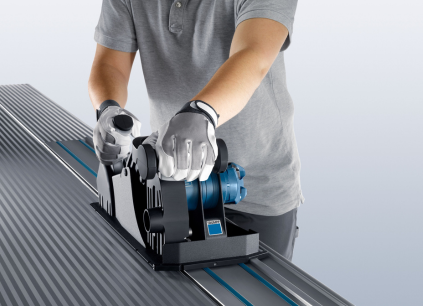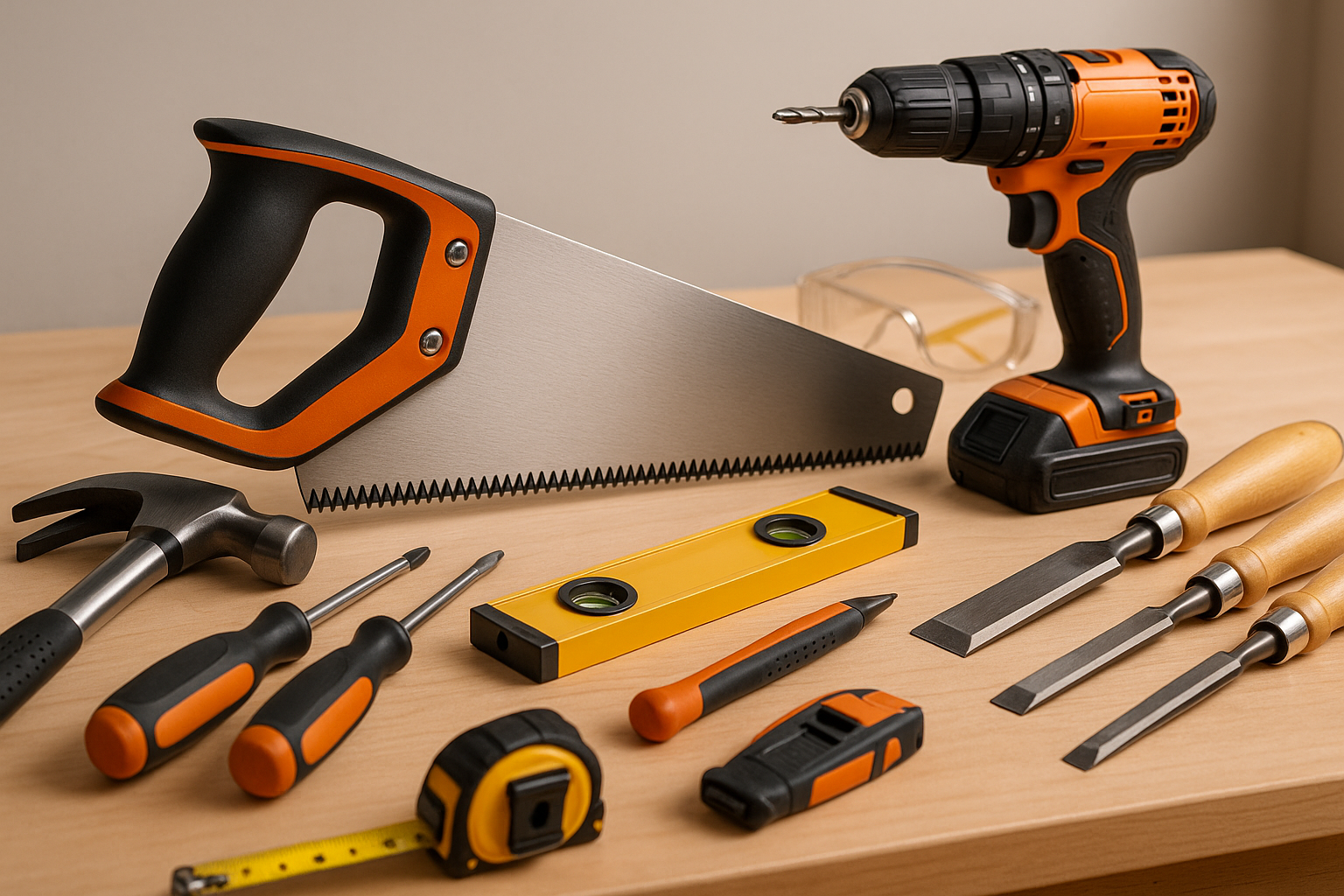What Tools Do You Need For A Cladding Installation?
It's crucial to always have the right tools for the job. And cladding installations are no exception. In this guide, we walk you through everything you need for a cladding installation, from what tools you need for metal cladding installation to how to cut a cladding sheet. Let’s delve into the various cladding installation tools available to you and when to use them.
Measuring
Before taking a panel cutter to your sandwich panels, you need to measure up. You’ll also want some tools to ensure your installation is lined up perfectly afterwards. You’ll need:
- A tape measure
Even the most precise panel cutter will make mistakes if the measurements are not accurate to begin with.
- A set square
Measure your angles with precision to ensure everything fits together seamlessly.
- String line and spirit level
Make sure everything is level over short (spirit level) and long (string line) distances.
Cutting composite panels
Panel cutters
No matter how precise your measurements are, you need a powerful and accurate cutting tool that delivers a clean finish for the best fit. Thankfully, we have the perfect panel cutter for you.
For panel cutters, we opt for a brand you will hear about a lot - Trumpf. They are the standout brand across the industry with a full range of power tools you know you can rely on. Their signature panel cutter, the TruTool TPC165, is no exception.
Here are some reasons we love the TPC165 for cutting sandwich panels…
The TruTool TPC 165 panel cutter cuts flat and profiled panels up to 200mm thick. There's no need to turn over your panels - the TPC 165 will cut right through. Plus, it is just as well suited to the soft materials (such as polyurethane, polyisocyanurate and mineral wool) inside the panel as the metal skin. You will have a clean cut with a high-quality finish throughout the panel. If you are working with thin panels, you can even cut two at once.
The TPC 165 is for more than just cutting your panels to the right length. It has a 90-degree adjustable blade allowing you to create precise cutouts and notches without requiring pilot holes. You can work around windows and doors with ease.
Cutting metal sheet wall panels
If you are using metal cladding sheets, you will need metal cladding tools! There are a number of tools available to cut them to the right size. The best tool for you will depend on the type, thickness and profile of the sheet as well as the desired cuts. You can choose from shears, slitting shears and nibblers.
Single cut shears
The first sheet metal cladding tool we will look at are shears, specifically single cut shears. This particular tool is well-known in the metal cladding installation world as they can create clean cuts without producing material waste.
Sheet metal shears have a high cutting capacity making them a fantastic option for heavy-duty tasks. However, they do produce some distortion to the material resulting in warping and bending at the edges.
If you need a reliable set of single cut shears we, again, recommend Trumpf. For sheets up to 1.6 mm thick, opt for the TruTool S160, or choose the TruTool S250 for thicker sheets up to 2mm.
Slitting shears
Another go-to tool for metal cladding installation, slitting shears are a great alternative to single cut shears and may be a better option for you, depending on the task. Slitting shears are capable of gliding through light gauge sheet metals making them a popular cladding tool. However, if you are looking for a tool to cut curves, you should opt for Nibblers instead.
Where slitting shears do excel, however, is cutting straight lines on light gauge metal. As slitting shears remove a thin strip of metal from their path, they can create clean cuts with minimal distortion, provided they are kept straight. They are perfect for flat sheets as well as a variety of profiles.
Slitting shears are designed for cutting a sheet in two (plus the thin strip removed from the middle). If you choose a model without a chip cutter, you must finish the cut through to the other side of the sheet.
If you are using light gauge wall panels which simply need some size adjustments, slitting shears might be the ideal cutting tool for your installation. Effortlessly cut your panels in two!
As with single cut shears, the best range for slitting shears is the TruTool range from Trumpf. The range includes the TruTool C160, TruTool C200, and TruTool C250 for cutting different thicknesses. The range also includes a selection of accessories so you can get even more from your tool.
Nibblers
Nibblers use a punch and die method to chew through the metal in front of them. They are a popular cladding tool as they do not distort the metal around the cut. Nibblers can cut straight lines as well as curves and more intricate shapes. This makes them popular among sculptors and creative metal workers but is also worth keeping in mind for your cladding project too.
Another bonus of nibblers is they are able to create cutouts from the middle of a metal sheet (using a drilled hole starting point) and can effortlessly cut through the peaks and troughs of corrugated metal, which sets it apart from other metal cladding installation tools.
SAFETY NOTE: Nibblers produce semicircular chips which can be sprayed out when cutting. Take necessary precautions as these chips can be sharp.
Our top picks for Nibbler cutting tools come from Trumpf. The TruTool Nibbler range has something for all your needs, including thin sheet nibblers, profile nibblers, and thick sheet nibblers, as well as solutions for diagonal and rounded cuts.
All three of the sheet metal cladding tool types listed above are excellent options. There is no best overall option, however. The right tool for your cladding installation will depend on your specific project and requirements.
How to Cut Cladding Sheets
As long as you have the right cladding tools and know how to use them properly, cutting cladding sheets will be a breeze. Remember to always take the appropriate safety precautions before starting to cut any cladding sheets.
1. Lay the Cladding Sheets onto a Flat Surface
Make sure your panels are on a flat surface so you can make precise cuts. The surface should also be stable so the sheet doesn’t move while you are cutting or marking the panel. We recommend using a workbench as you can easily attach some clamps to hold the cladding sheet down.
2. Measure and Mark Where to Cut
With a tape measure and a set square, measure and mark the panel to meet your requirements. Remember to check your measurements multiple times to avoid any mistakes!
3. Cut the Cladding Sheets with the Appropriate Tools
Now that your panels are marked and you have triple checked your measurements, it is time to start cutting. The cladding tool you will use depends on the type of cladding sheet and cut that you want to perform. To remind you, here is a summary of our go-to cladding tools and what they are designed for:
- Panel Cutters: A panel cutter is essentially a large saw that can be moved across a cladding panel to make clean straight cuts. They are suitable for composite panels but we would not recommend them for metal cladding sheets.
- Single Cut Shears: Single cut shears are handheld tools that are capable of cutting through heavy duty metal sheets without wasting material.
- Slitting Shears: With its ability to easily slice through light gauge metal sheets, slitting shears are great for cutting straight lines through metal cladding.
- Nibblers: If you are looking for a cladding tool to cut curves as well as straight lines, you could opt for nibblers. This metal cladding tool can also be used to cut through corrugated metal sheets, easily adapting to the peaks and troughs, making it a helpful tool to have on hand during any metal wall cladding installation.
4. Make Sure the Cladding Sheets are Cut Perfectly
For cladding sheets that need to fit snug around obstacles like windows, make sure to check your measurements multiple times. This way you can reduce the chance of making mistakes and adjust your measurements before you take the plunge and cut the cladding. Once cut, you should do a fit test to make sure it fits in place perfectly.
Moving and lifting cladding panels
If you want to make your installation even easier and safer, you can reduce the manual handling workload with vacuum lifters. A portable GRABO vacuum lifter will make light work of lifting and transporting your panels. For larger projects, VIAVAC vacuum lifters deliver everything you need. They have a wide range of models accommodating panels of all sizes up to weights of 800kg.
Fitting cladding panels
Once your cladding panels are cut to size, you will need a few more things to complete your installation. You will need a hand drill to secure the cladding screws to the panel. You will also require the appropriate fixings for the panels you are using.
Buy cladding tools for your installation
If you would like to purchase or hire any of the equipment discussed in this guide, get in touch. We stock a full range of power tools and cladding and roofing equipment. We also supply manual handling vacuum lifters, and VIAVAC lifters are available through our 4 Cladding Services brand.
Not sure what tools are right for you? No problem. We are a team of cladding tool specialists, and we would love to help you make an informed choice to help your project run smoothly and more safely.
Speak with a cladding expert today.
Frequently Asked Questions
How do you cut corrugated cladding?
If you have corrugated cladding sheets, we recommend you use nibblers. These specialised cladding tools are not only great for cutting curves and straight lines but they can also easily adapt to the peaks and troughs of corrugated cladding sheets.
What is the best thing to cut cladding with?
There are a range of cladding tools on the market but knowing which one is best for your project can be difficult. We recommend:
- Panel Cutters: For making straight clean cuts on composite cladding panels.
- Single Cut Shears: For cutting through heavy duty metal sheets.
- Slitting Shears: For cutting through light gauge metal sheets.
- Nibblers: The ultimate metal cladding tool, great for cutting curves, straight lines and corrugated metal sheets.
How is metal cladding installed?
Metal cladding is typically installed by first attaching a framework of vertical and horizontal battens to the building’s structure. The metal sheets of cladding are then secured to this framework using specialised fasteners or clips, ensuring proper alignment and overlap. Flashing and trims are added around any opening and edges to create a watertight seal and make for a finished appearance. Remember, you will need to use metal cladding tools to complete any metal wall cladding installation!
Learn more about cladding tools
Make sure you are prepared for your next cladding project with more insightful guides like this. Here are some more great reads which can help you choose the right tools for the job and improve onsite efficiency and safety:


